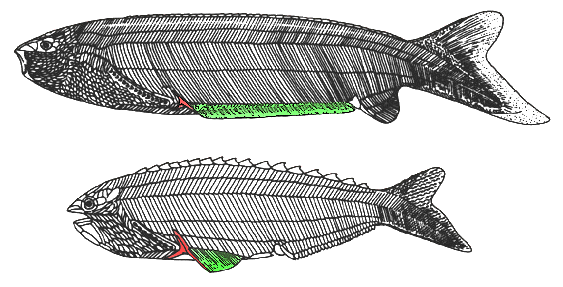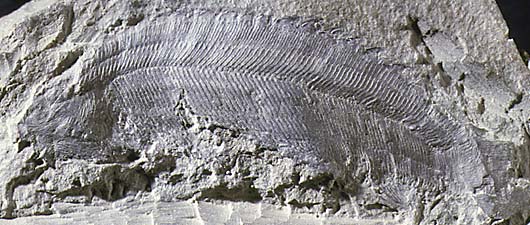Anaspida
Philippe Janvier



This tree diagram shows the relationships between several groups of organisms.
The root of the current tree connects the organisms featured in this tree to their containing group and the rest of the Tree of Life. The basal branching point in the tree represents the ancestor of the other groups in the tree. This ancestor diversified over time into several descendent subgroups, which are represented as internal nodes and terminal taxa to the right.

You can click on the root to travel down the Tree of Life all the way to the root of all Life, and you can click on the names of descendent subgroups to travel up the Tree of Life all the way to individual species.
For more information on ToL tree formatting, please see Interpreting the Tree or Classification. To learn more about phylogenetic trees, please visit our Phylogenetic Biology pages.
close boxThe main characteristics supporting the nodes of this phylogeny are:
- Node 1: Ten or less than ten external branchial openings
- Node 2: Reduced anal fin, short-based paired fins, large median dorsal scutes
- Node 3: Loss of anal fin, larger and hook-shaped median dorsal scutes
Introduction
The Anaspida, or anaspids, are a group of fossil, jawless vertebrates which lived in the Silurian (-430 to -410 million years ago). Anaspids differ from most other "ostracoderms" by their dermal skeleton not forming a massive headshield, although their head is covered by both large bony plates and minute scales. Also, contrary to most other "ostracoderms", they have a rather slender and laterally compressed body, with the gill openings extending behind the eyes in a slanting row, as in lampreys. The tail of anaspids is strongly hypocercal (or reverse heterocercal); that is, the part containing the notochord dips posteroventrally. On the top of their head, there is a median hole in the skull-roof, which is interpreted as a nasohypophysial opening similar to that of lampreys, yet there is no information of their internal anatomy. They differ, however, from lampreys in having paired fins. All these characteristics make anaspids roughly look like lampreys and they have long been regarded as their ancestors. Current phylogenies, however, imply that anaspids, along with other "ostracoderms", are more closely related to the gnathostomes than to lampreys. Yet, their phylogenetic position fluctuates considerably.
Anaspids lived in marine, coastal environments. They are rarely found as articulated fossils, since their skeleton was comparatively fragile. The best preserved anaspids are from the Silurian of Norway and Scotland.
Characteristics
The Anaspida are characterized by:- At least one large, tri-radiate spine behind the series of the gill openings.
 Click on an image to view larger version & data in a new window
Click on an image to view larger version & data in a new window
Anaspids are characterized by a large, tri-radiate spine (red) posteriorly to the series of branchial openings. Typical anaspids are restricted to the Silurian but some doubtful forms occur in the Late Devonian. It is assumed that the most primitive anaspids, such as Pharyngolepis (top), possessed a long, ribon-shaped, ventrolateral fin-fold (green). More advanced forms, such as Rhyncholepis (bottom), possessed a shorter paired fin-fold (green) and enlarged, spine-shaped, median dorsal scutes. (After Ritchie 1964, 1980.)
All typical anaspids are Silurian in age. Several forms of debated affinities have also been included in this group: the Silurian Jamoytius, and the Late Devonian Endeiolepis and Euphanerops. Although the latter two genera share with the Anaspida a strongly hypocercal tail, a characteristic which is unknown in other groups, they have no mineralized exoskeleton and, therefore show no tri-radiate postbranchial spine. Both Jamoytius and Euphanerops display a very long series of more than twenty gill openings, and a circular structure around the mouth, which may be an annular cartilage, and thus would suggest affinities with lampreys (see Hyperoartia).
Anaspids have a laterally compressed body, a large dorsal web and a hypocercal notochordal lobe in the caudal fin, and an anal fin. They clearly possess thin, sometimes ribon-shaped paired fins, but it is uncertain whether these contained musculature and radials. The body is covered with rod-shaped scales arranged in chevrons, and the head is covered with minute scales and platelets forming the skull-roof. The gill opnings (8 to 15 in number) are minute and aligned in slanting row behind the eye. The skull-roof displays a median pineal opening, between the two orbits, and in front of it there is a peculiar keyhole-shaped opening interpreted as a dorsal nasohypophysial opening. However, since nothing is known of the internal anatomy of anaspids, there are still debates as to whether it corresponds to a blind nasohypophysial complex of lamprey type, or to an inhalent duct leading to the pharynx.
The exoskeleton of anaspids is made up of aspidine and contains no dentine. Some anaspids (e.g. Lasanius), however, are almost naked and retain only the postbranchial spines and the large median dorsal series of hook-shaped scute. Their endoskeleton was probably cartilaginous and is not preserved. However, some naked Silurian and Devonian forms often referred to as anaspids (Jamoytius, Endeolepis, Euphanerops) show imprints of a branchial skelton which may have been more or less similar to the "branchial basket" of lampreys.
Discussion of Phylogenetic Relationships
Anaspids are classically regarded as close relatives or ancestors of lampreys. However, all the characteristics which were considered as supporting this relationship (dorsal nasohypophysial opening, gill opening in posteriorly slanting row, hypocercal tail) occur in some other fossil "ostracoderm" taxa. Only their slender body shape is somewhat suggestive of that of lampreys. Current character analyses show anaspids in various phylogenetic positions (sister-group to all other "ostracoderms" + gnathostomes or sister-group to galeaspids + osteostracans + pituriaspids + gnathostomes). This is largely due to the lack of information about their internal anatomy.
The most generalized anaspids are exemplified by Pharyngolepis. More derived forms include the Rhyncholepididae and Birkeniidae, in which the anal fin is reduced or lost and the median dorsal ridge scales considerably enlarged. The birkeniid Lasanius has lost most scales, with the exception of the tri-radiate postbranchial spines and the median dorsal ridge scales.
References
Arsenault, M. and Janvier, P. (1991). The anaspid-like craniates of the Escuminac Formation (Upper Devonian) from Miguasha (Québec, Canada), with remarks on anaspid-petromyzontid relationships.In Early vertebrates and related problems of evolutionary biology (ed. M. M.Chang, Y. H. Liu, and G. R. Zhang) pp. 19-40, Science Press, Beijing.
Janvier, P. (1996). Early vertebrates. Oxford Monographs in Geology and Geophysics, 33, Oxford University Press, Oxford.
Kiaer, J. (1924). The Downtonian fauna of Norway. 1. Anaspida. Skrifter utgitt af det Norske Videnskapsakademien, 1, matematisk-naturvidenskapslige Klasse, 6, 1-139.
Parrington, F. R. (1958). On the nature of the Anaspida. In: Studies on fossil vertebrates (ed. T. S. Westoll), p.108-128, The Athlone Press, London.
Ritchie, A. (1964). New light on the morphology of the Norwegian Anaspida. Skrifter utgitt av det Norske Videnskaps-Akademi, 1, Matematisk-Naturvidenskapslige Klasse, 14, 1-35.
Ritchie, A. (1968). New evidence on Jamoytius kerwoodi White, an important ostracoderm from the Silurian of Lanarkshire, Scotland. Palaeontology, 11, 21-39.
Ritchie, A. (1980). The Late Silurian anaspid genus Rhyncholepis from Oesel, Estonia, and Ringerike, Norway. American Museum Novitates, 2699, 1-18.
Ritchie, A. (1984). Conflicting interpretations of the Silurian agnathan, Jamoytius. Scottish Journal of Geology, 20, 249-256.
Stensiö, E.A. (1964). Les Cyclostomes fossiles ou Ostracodermes. In: Traité de paléontologie (ed. J. Piveteau), Vol. 4(1), pp. 96-383, Masson, Paris
White, E. I. (1946). Jamoytius kerwoodi, a new chordate from the Silurian of Lanarkshire. Geological Magazine, 83, 89-97.
Title Illustrations

| Scientific Name | Pterygolepis nitidus |
|---|---|
| Location | Norway |
| Specimen Condition | Fossil -- Period: Lower Silurian |
| Image Use |
 This media file is licensed under the Creative Commons Attribution License - Version 3.0. This media file is licensed under the Creative Commons Attribution License - Version 3.0.
|
| Copyright |
© 1997

|
About This Page

Muséum National d'Histoire Naturelle Paris, France
Page copyright © 1997
 Page: Tree of Life
Anaspida.
Authored by
Philippe Janvier.
The TEXT of this page is licensed under the
Creative Commons Attribution License - Version 3.0. Note that images and other media
featured on this page are each governed by their own license, and they may or may not be available
for reuse. Click on an image or a media link to access the media data window, which provides the
relevant licensing information. For the general terms and conditions of ToL material reuse and
redistribution, please see the Tree of Life Copyright
Policies.
Page: Tree of Life
Anaspida.
Authored by
Philippe Janvier.
The TEXT of this page is licensed under the
Creative Commons Attribution License - Version 3.0. Note that images and other media
featured on this page are each governed by their own license, and they may or may not be available
for reuse. Click on an image or a media link to access the media data window, which provides the
relevant licensing information. For the general terms and conditions of ToL material reuse and
redistribution, please see the Tree of Life Copyright
Policies.
Citing this page:
Janvier, Philippe. 1997. Anaspida. Version 01 January 1997 (under construction). http://tolweb.org/Anaspida/14837/1997.01.01 in The Tree of Life Web Project, http://tolweb.org/







 Go to quick links
Go to quick search
Go to navigation for this section of the ToL site
Go to detailed links for the ToL site
Go to quick links
Go to quick search
Go to navigation for this section of the ToL site
Go to detailed links for the ToL site